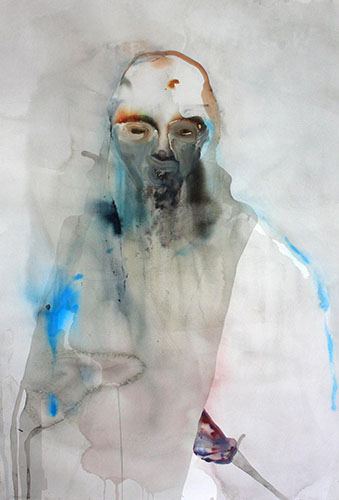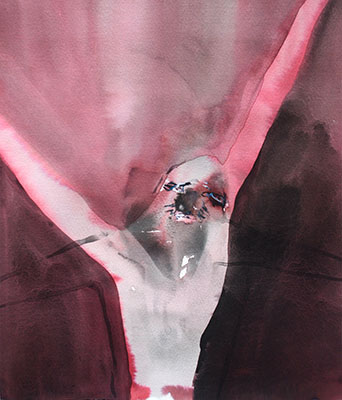 |
.jpg) |
On the opposite wall from Ruznic’s paintings are the six larger oil works by Hagler. Each is based on a specific scene from Jim Jarmusch’s 1995 black-and-white psychedelic western Dead Man, starring Johnny Depp. The film follows Bill Blake, the titular dead man, who is simultaneously a milquetoast accountant turned outlaw and a reincarnation of visionary poet William Blake. Hagler has been interested in the symbolism of Dead Man for more than 15 years. His recent body of work, The Unsurrendered, used 19th century western vernacular paintings as a “skeleton” for images of gods and superheroes. This gave Hagler a segue into Dead Man as a further exploration of his own “spiritual wilderness” absent in the religion of his childhood. Hagler contends that William Blake was already dead before he was shot with “the white man’smetal”. For Hagler, then, the film is about redemption, a kind of Passion for the visionary artist to redeem his soul from the sin imposed by the mechanization and violence of western culture. This, however, is not so much a linear path as it is a repeating purgatory. That’s why Hagler titled the piece depicting the final scene of the film with a quote from the beginning: And then later that night, you were lying, looking up at the ceiling and the water in your head was not dissimilar from the landscape, and you think to yourself, ‘why is it that the landscape is moving but the boat is still?’
 |
Though the film is black and white, Hagler applies his own palette of somber violets and blacks and soaring whites, yellows and golds to activate the religious iconography inherent in the subject. The work often bleeds into abstraction, at moments dissolving the imagery entirely. Both the palette and the abstraction resonate with Ruznic’s work. These painters, who live together and work in the same space have obviously influenced one another, though their approaches remain distinct. Ruznic, who was a young girl refugee from the Bosnian War in 1992, tints her work with the kind of gallows humor of a survivor, shown in titles like Death Has a Friend and He Sucks and So Does She. Hagler attempts to break free of his own anxieties as the heir of colonists and usurpers. Both find reckoning in their painting.